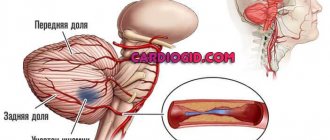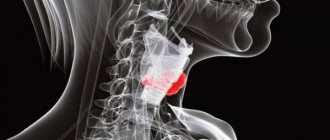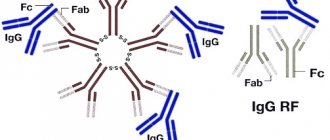Ultrasound of the abdominal organs is performed to diagnose a huge number of diseases of the largest and most important organs. This procedure includes diagnostics of not only the organs themselves, but also their individual structures (arteries, veins, lymph nodes).
There is even a separate procedure - ultrasound of the abdominal aorta and its branches. It detects such dangerous diseases as aneurysms, malformations and stenoses (compression of blood vessels).
In this article we will talk about how to prepare for an ultrasound of the abdominal organs, what a GBS study is and how to interpret an ultrasound of the abdominal cavity. We will also talk about what specific pathologies this study shows.
How to perform examination of internal organs
Ultrasound of the abdominal organs and retroperitoneal space is performed through the abdomen with the patient in the supine or lateral position. Kidney examinations are sometimes performed while sitting or even standing. Thus, preparation for the examination partly depends on how an abdominal ultrasound is performed.
Why do an ultrasound of the OBP, how informative is this study? Ultrasound of internal organs allows you to measure the size of parenchymal organs, study the condition of the tissues of each organ separately, and check specific parameters.
What is included in an abdominal ultrasound
Abdominal ultrasound is a diagnostic procedure that visualizes the organs and structures of the abdominal cavity and pelvis by detecting ultrasound waves. This examination is one of the best options for diagnosing diseases of the liver, spleen, pancreas, gall bladder, kidneys, bladder and female reproductive organs.
In addition, ultrasound is used to examine the vessels and lymph nodes of the abdominal cavity, and also determine the free fluid in it.
Abdominal organs
If you start from the upper third of the abdomen, the abdominal cavity includes: liver and gall bladder, pancreas, spleen. Under certain conditions, an ultrasound scan of the initial part of the small intestine (duodenal bulb) can be performed. Using a sonographic examination, dense parenchymal organs can be examined; the condition of the intestine cannot be checked using ultrasound. The intestines are mostly filled with air and semi-liquid contents.
When the abdomen is bloated or during diagnostic and treatment procedures (for example, gastroscopy or colonoscopy), the intestinal loops are further expanded by air. Ultrasound easily passes through the air cushion, but is reflected not from the intestinal wall, but from the underlying dense structures, because of this the sonographic picture is distorted.
In case of pathology of the gastrointestinal tract, during an ultrasound of the organs of the gastrointestinal tract, one can often see dense neoplasms, foreign bodies, and fecal stones. Since it is impossible to fill the entire intestine with a liquid that better reflects ultrasound, examination of the intestine with ultrasound of internal organs is impractical.
Liver and gallbladder
Photo of the liver. Impaired blood flow, damage by viruses, the formation of stones, the appearance of tumors, and cysts lead to pathological changes in the liver. Currently, liver diseases are very common in our country, so ultrasound diagnostics is of great importance.
The liver is a parenchymal organ located in the right hypochondrium; on the lower surface of the liver there is a gallbladder. Liver ultrasound is prescribed for palpable enlargement of the organ (the edge of the liver protrudes from under the costal arch), increased liver transaminases, icteric discoloration of the skin and mucous membranes, bitterness in the mouth, increased bleeding, etc.
When examining the liver, the structures of the hepatic parenchyma, the condition of the bile ducts and large vessels, especially the portal vein, are checked. The size of the organ, its lobes and segments is measured, and the edge of the liver is examined. Also, during liver ultrasound, the gallbladder is additionally studied: its ability to contract, the state of its contents (presence of stones, bile viscosity). Ultrasound of the liver and gallbladder can reveal pathologies:
- cirrhosis,
- fibrosis,
- neoplasms,
- cysts,
- gallbladder stones.
What liver diseases can be detected using abdominal ultrasound:
- hepatitis: infectious, toxic-nutritional, alcoholic;
- neoplasms (it is impossible to judge from the results of sonography whether a neoplasm is benign or malignant);
- parasitic hydatid cysts;
- calculous and non-calculous cholecystitis;
- liver injuries and ruptures.
Pancreas
The pancreas is adjacent to the liver on one side and the spleen on the other. The pancreatic bile duct connects the pancreas to the duodenum. Ultrasound of the pancreas is prescribed for girdle pain, elevated enzymes in the biochemical blood test (in particular amylase).
During an ultrasound examination, the size of the gland is measured (separately the head, body and tail, and the entire organ as a whole), and the condition of the pancreatic duct is checked.
Ultrasound examination of internal organs can reveal changes in the condition of the pancreatic parenchyma: swelling and increase in acute pancreatitis and decrease in atrophy or pancreatic necrosis; changes in gland tissue - neoplasms and foci of necrosis.
What diseases of the pancreas can be detected using abdominal ultrasound:
- acute and chronic pancreatitis;
- pancreatic necrosis;
- pancreatic neoplasms;
- injuries and ruptures of the pancreas.
Spleen
The spleen is the main blood depot in an adult. In addition to depositing blood, the spleen is a “graveyard of red blood cells.” It is here that old and pathological red blood cells are destroyed. The spleen is very well vascularized, so when it ruptures, severe internal bleeding occurs, leading to splenectomy. Sonography of the spleen is mandatory in case of closed injuries of the abdomen, or with an enlarged spleen.
Ultrasound diagnostics of the spleen is prescribed to the patient by the attending physician if there is a suspicion of the development of a pathological process, according to the indication of possible surgical amputation of this organ. The photo shows a picture of the spleen from an ultrasound machine
With blunt trauma to the abdomen, for example, during falls from a height, car accidents, complete or subcapsular rupture of the spleen often occurs. If a complete rupture occurs, emergency removal of the organ is necessary. A subcapsular rupture, like a time bomb, can turn into a complete rupture at any time, which also requires splenectomy.
During an ultrasound of the abdominal organs, the dimensions of the spleen are measured: length, width, thickness. You can also measure the area of the organ and check the condition of the splenic vein.
What pathologies can be detected with abdominal ultrasound?
- splenomegaly - enlargement of the spleen (with damage to the hematopoietic system or viral diseases, such as mononucleosis);
- Complete or subcapsular rupture of the spleen.
Preparation for the abdominal ultrasound procedure
In order for the doctor conducting the diagnosis to be able to obtain the most reliable and objective information about the state of health of the patient’s internal organs, care should be taken to take preparation measures, which include the formation of a diet consisting of food that cleanses the gastrointestinal tract cavity from all excess and unnecessary deposits . Therefore, the preparatory process before ultrasound of the OBP is a set of measures consisting of the following actions.
Eating before ultrasound OBP - on an empty stomach or not, how long before you can eat?
The ultrasound examination procedure should be carried out on an empty stomach so that the patient's stomach remains empty. 3 days before the start of diagnosis, gas-forming foods such as cabbage, radishes, carrots, all types of legumes, walnuts and peanuts, and fatty meats are completely excluded from the diet. Alcohol and carbonated drinks are also strictly prohibited. You should not eat later than 12 hours before the doctor performs an ultrasound examination of the abdominal organs. In addition, you should take a laxative at night to naturally cleanse the intestines of feces and other fecal deposits.
3 hours before the main examination, you are allowed to drink 250 grams of water, but not later than the specified time interval. All this will be reflected in the results of the examination and will form the basis of the doctor’s medical report, which means it will also affect the diagnosis. It will not be difficult for an adult to perform these simple procedures. Over the next 3 days, preference should be given to cereal porridges seasoned with a small amount of butter, salads of fresh vegetables and herbs, fruits, boiled meat, and still mineral water.
Drinking plenty of fluids is the key to natural cleansing of the gastrointestinal tract.
Taking Espumisan
This drug is intended to relieve excess flatulence. It is necessary to understand that during the process of fermentation and other negative biochemical reactions occurring inside the abdomen, stretching of the tissues of the internal organs of the abdominal cavity occurs. All this does not make it possible to fully reflect the natural state of the gastrointestinal tract. Therefore, preparation of the peritoneum is required before ultrasound diagnostics. Espumisan is best suited for this. For 3-5 days, a person takes 1 tablet of the medication with meals, washing it down with a small amount of water.
Is it possible to smoke before an ultrasound?
There are no direct contraindications for the use of tobacco products. Despite this, gastroenterologists strongly recommend quitting smoking in order to improve the health of the cells of the digestive, excretory and endocrine systems. This will eliminate the factor of distortion in deciphering diagnostic results, and will also show the true norm of each internal organ separately.
It is also important to remember that when you inhale cigarette smoke, air involuntarily enters the stomach cavity. This factor can lead to the computer monitor displaying an overly increased volume of this organ of the digestive system.
How to prepare a child for research?
It is much easier for an adult to complete all the preparatory procedures before an abdominal ultrasound than for children of different age groups. This is primarily due to a number of psychological barriers. Therefore, the child needs to be morally conditioned to the fact that ultrasound examination of OBP is absolutely not painful. You just need to lie down, relax and wait while the doctor performs a series of simple movements on the surface of the abdomen. It is possible that there will be a slight cold due to the liquid that is used in the diagnostic process, but nothing more.
Kidneys and retroperitoneum
After an ultrasound of the abdominal cavity, they proceed to examination of the kidneys and the initial parts of the ureters, bladder, and cellular spaces.
Kidneys and adrenal glands
The kidneys are a paired organ located in the lumbar region, in the retroperitoneal space. A kidney examination is prescribed by a doctor if there are changes in the general urine test, edema, arterial hypertension, pain in the lumbar region, or pain when urinating. Ultrasound of the adrenal glands is recommended for suspected Addisson's disease and Itsenko-Cushing's disease (syndrome).
When examining the kidneys, their size is measured, the structure of the renal parenchyma, the condition of the renal calyces and pelvis are studied. During the examination, the doctor records the contractility of the pelvis. Ultrasound of the kidneys and retroperitoneal space can reveal changes in the renal parenchyma, kidney stones and tumors, pathology of the adrenal glands and neoplasms of the retroperitoneal space.
What diseases can be detected:
- Congenital and acquired defects: hydronephrosis, megaloureter, pyelectasia, calicopyelectasia, renal agenesis;
- Glomerulonephritis, pyelonephritis, amyloidosis - sonography results indirectly indicate changes in the renal parenchyma;
- Neoplasms of the kidneys and adrenal glands.
Bladder
Bladder examination is most effective with proper preliminary preparation - a full bladder. In principle, abdominal ultrasound is most informative with proper preparation.
Ultrasound of the abdominal cavity, which is included in the minimum preparation:
- diet 3-4 days before the test;
- taking medications that help reduce gas formation in the intestines;
- taking laxatives or a cleansing enema the evening before the test;
- full bladder.
Of course, we can talk about preliminary preparation during routine examinations. Emergency ultrasound of internal organs is done under any conditions.
Ultrasound of the bladder is recommended for difficulty urinating, pain when urinating, changes in the general urine test (salt, sediment).
What characteristics of the bladder can be checked with an abdominal ultrasound? First of all, the presence or absence of concretions (stones) and wall tumors. Also, when examining the bladder, indirect signs of diseases can be detected: vesicoureteral reflux, vesico-rectal and vesico-uterine fistulas.
Ultrasound diagnostics is one of the most important methods for examining internal organs. It is given routinely to children, and is prescribed to adults if a disease is suspected or for preventive purposes. This diagnostic technique allows you to identify most ailments that affect the anatomical structure of the organ. How is an abdominal ultrasound performed, and what diseases can it detect?
Why is an abdominal ultrasound performed?
Ultrasound of the abdominal cavity is the most important diagnostic procedure, which allows us to identify many diseases affecting the organs located in it. Functional disorders cannot be detected using sonography, but structural pathologies of the organ are clearly visible under the influence of sound waves.
The table shows the pathologies that ultrasound shows:
| Body system | Organ | Illness |
| Digestive | Gallbladder |
|
An abdominal ultrasound is prescribed for the following symptoms:
| Liver |
| |
| Pancreas |
| |
| excretory | Kidneys |
|
| Lymphoid | Spleen |
|
| Lymph nodes |
| |
| Blood | Aorta |
|
- aching, cutting, pressing sensations in the abdomen;
- bloating, excessive gas formation;
- sudden weight loss for no apparent reason;
- yellowness of the skin;
- bitter taste in the mouth;
- abdominal trauma.
Indications for use
Before the doctor decides to prescribe an abdominal ultrasound to the patient, he discovers a number of pathological symptoms in him, indicating a painful condition of individual organs or the entire system. Therefore, there are the following indications for this type of diagnosis:
- acute and prolonged pain inside the abdomen, which is relieved only with the help of potent analgesics, and then returns again,
- internal bleeding and defecation mixed with capillary blood,
- lack of appetite, which is accompanied by nausea and vomiting of unknown origin,
- discoloration of stool, or feces becoming a rich dark or green shade,
- acute urinary retention, urine leakage or kidney dysfunction,
- heartburn, pain localized in the area of the right, left hypochondrium or solar plexus.
In some cases, this symptomatology of a current disease of the internal organs is accompanied by an increase in body temperature ranging from 37 to 39 degrees Celsius. Also, other indications for the use of abdominal ultrasound cannot be excluded, which can be detected by a gastroenterologist.
How is the research carried out, is special preparation required?
Ultrasound diagnostics of the abdominal cavity is carried out using a sonograph. The patient lies down on the couch, and the doctor lubricates the examination area with a special gel, which will provide a layer between the device and the skin and minimize the formation of air bubbles.
The sensor generates ultrasonic waves that penetrate deep into the organs. They are reflected or absorbed by tissues of different structures, and the same device detects their reflection. At the request of the doctor, the patient may need to hold his breath, inflate or relax his stomach. The whole procedure lasts about 15-20 minutes. The resulting image is displayed on the device screen. You can print the ultrasound results from the monitor and send them to your doctor.
How to prepare in advance for an ultrasound scan? You should not eat or drink before the examination. The last meal should be in the evening of the previous day. If the diagnosis is scheduled for the afternoon, then you are allowed to drink.
Two days before the ultrasound, you should stop taking medications that relax your muscles. You need to take activated charcoal in advance to cleanse the stomach and intestines. If the bladder is to be examined, it must be full, which means the patient needs to drink 1-1.5 liters of water before visiting the doctor.
Indicators that are measured during the study, their norms in adults and children
What indicators are normal in the absence of diseases of the internal organs? Norms of liver ultrasound indicators:
Norms for the gallbladder:
Norms for the spleen:
- length - 11 cm;
- thickness - 5 cm;
- longitudinal section - 40 sq.cm;
- splenic index - 20 sq.cm.
Kidney ultrasound results are normal:
- length - 11 cm;
- width - 5-6 cm;
- thickness - 4-5 cm;
- parenchyma - 2.3 cm.
Normally, the lymph nodes are not visible, the sonologist writes as much in the conclusion. In children, the size of organs depends on their age, so a pediatric specialist should be involved in decoding. However, the norms for structure, echogenicity and absence of additional formations in children are the same as in adults.
Nutrition before ultrasound
Eating and drinking properly in preparation for a test is the best insurance against an ineffective diagnosis. And although you can properly prepare in terms of nutrition one day before the ultrasound, it is better to do this at least three days before the examination.
The main goal of preparing for the study is not to distort the results obtained and the conclusion of the procedure. And first of all, for this you need to significantly reduce the amount of gases in the intestines.
This can be done simply by eating and drinking the right foods, but it is better to add medications. Dietary recommendations (with a list of permitted and most acceptable foods ) are as follows:
- from meat you can eat as much boiled beef, chicken or quail meat as you like;
- from fish products, you can eat steamed, baked or boiled fish, always low-fat varieties, as much as you want;
- you can also eat no more than 1 chicken egg per day (exclusively hard-boiled);
- from porridges it is allowed to consume as much pearl barley, buckwheat and oatmeal as you like;
- Hard cheese is allowed (but only low-fat).
Prohibited Products
In this case, it is correct to eat fractionally, approximately every three hours a day. It is not recommended to drink water during meals; it is better to do this at least an hour after.
Visualization of the abdominal cavity on ultrasound
If we talk about those foods and drinks that should not be consumed before the procedure :
- you cannot drink carbonated and sweet drinks (you can only water and unsweetened tea);
- you can’t drink alcohol;
- milk and any dairy products (even yoghurts) are prohibited;
- caffeinated drinks;
- black bread;
- fatty fish and meats;
- raw vegetables and fruits;
- any sweets.
It is much more difficult for children to prepare for this procedure in terms of giving up sweets than for adults. Therefore, parents with children need to carry out explanatory work in advance, motivating them to buy sweets or toys after the ultrasound.
Preparing for an abdominal ultrasound (video)
Medication preparation
If the procedure is carried out in children, then they are recommended to take drugs such as Espumisan and its derivatives (Infacol, Kuplaton) during preparation. These drugs should be taken for three days before diagnosis in an age-specific dosage.
If the procedure is performed on adults, then they can also be prescribed the drugs listed above. But for adults, it would be a good idea to take activated charcoal the day before the procedure. The fact is that activated carbon effectively cleanses the intestines of gases, which, in fact, is what needs to be achieved.
It is very important to do a bowel cleanse the day before the test. It is advisable to do this at approximately 16:00 on the day before the procedure. Of the classic methods of cleansing the intestines, an Esmarch mug with a liter of cool (but not warm) water is suitable.
But there are alternative, more gentle, ways to cleanse the intestines. This is how you can cleanse your intestines using:
- Herbal laxatives (usually Senade).
- The drug "Fortrans" (it begins to act 3 hours after use).
- Microclysters "Norgalax" or their analogue "Microlax". The second option is more suitable for children.
Ultrasound results of the spleen
Deciphering the diagnosis of the spleen. Normal indicators:
- length: up to 11 cm;
- thickness: up to 5 cm;
- longitudinal section: up to 40 cm2;
- vessel pattern: normal;
- homogeneous structure;
- the splenic vein is located at the hilum.
Ultrasound of the peritoneal organs
There are relatively few diseases of the spleen. Here is a list of clinical landmarks indicating pathologies of the spleen:
- An increase in the size of the spleen may indirectly indicate cirrhosis of the liver or infectious diseases of the spleen.
- Induration of the spleen. This ultrasound result may indicate a splenic infarction or the presence of thrombosis of its vessels.
- Tissue divergence. This diagnostic result can only indicate a splenic rupture.
Ultrasound results of the gallbladder
Decoding the diagnosis of the gallbladder. Normal indicators:
- size standards: 3-5 cm width, 6-10 cm length;
- volume standards: 30 – 70 cubic meters. cm;
- wall thickness standards: up to 4 mm;
- absence of formations in the lumen;
- absence of vascular dysplasia.
Gallbladder diseases have become increasingly common in recent years. Let us note the ultrasound signs of the most common of them:
- thickening of the walls of an organ with normal dimensions indicates acute cholecystitis;
- thickening of the walls with clear and dense contours indicates chronic cholecystitis;
- organ deformations are not pathologies, they are just structural features;
- echo-negative objects with an acoustic shadow indicate calculous cholecystitis.
Liver ultrasound results
Interpretation of liver ultrasound has the following normal indicators:
Diagnosis of the liver using ultrasound of the abdominal cavity
- normal dimensions of the right lobe: up to 12.5 cm;
- left: up to 7 cm;
- caudate: 30-35 cm;
- contours: smooth;
- vessel pattern: normal.
There are a huge number of liver diseases. We note only the signs visible on ultrasound, which indicate the most dangerous of them:
- Increased echo density and rounding of the liver edge. This ultrasound result indicates fatty liver hepatosis.
- Dilation of blood vessels and liver size relative to normal, uneven contours of organs. Most often this is cirrhosis.
- An increase in the size of the liver vessels and the rounding of its edges indicate stagnant processes in this organ due to heart disease.
- The presence of foci with a violation of the normal echostructure most often indicates liver abscesses.
Decoding the research results
The ultrasound of the abdominal cavity is interpreted by a sonologist or a specialist who referred for examination - a hepatologist, oncologist, nephrologist. How to determine pathology by ultrasound? The doctor looks at the deviation from normal values and compares them with the obtained values.
The table shows a breakdown of the results and the presumed diagnosis:
| Organ | Decoding indicators | Presumable diagnosis |
| Gallbladder | Dense wall, hypoechogenicity, blurred contour. | Acute cholecystitis |
| Reduced echogenicity, clear outlines, deformation of the structure. | Chronic cholecystitis | |
| Increased echo, moving shadow. | Stones in the gallbladder | |
| Liver | Enhanced and rapid signals, hypertrophy, the portal vein with compacted parenchyma is visible. | Hepatosis |
| Uneven edges, changes in echostructure, enlarged spleen, dilated veins, fluid in the abdominal cavity. | Cirrhosis | |
| Changes in echogenicity and size, convex borders. | Focal neoplasms | |
| Pancreas | Diffuse enlargement, blurry contours, reduced echostructure. | Swelling due to inflammation |
| Decreased echostructure, unclear foci, shift of the inferior vena cava, increased diameter of the Wirsung duct. | Tumors or cysts | |
| Kidneys | Hyperechoic, moving formations. | Kidney stones |
| Narrowed or enlarged sinus, hypoechogenicity. | Pyelonephritis | |
| Spleen | Increased density, hyperechogenicity, uneven edges, organ hypertrophy. | Heart attack or rupture of the spleen |
| Lymph nodes | Visible on ultrasound. | Infection, cancer of the lymphatic system or metastases of other organs |
The conclusion after the study is drawn up by a sonologist who fills out a special form. Then the attending physician gets acquainted with this medical document and, based on its contents and the results of additional tests, makes a diagnosis.
9 minutes Author: Irina Bredikhina 17293
Interpretation of the results of many studies is quite difficult and requires high professionalism. And with diagnostic procedures aimed at studying several organs at once, it becomes even more difficult to correctly describe the materials obtained.
Deciphering an ultrasound scan of the abdominal cavity is considered to be exactly such an event. So that, based on the examination materials, the attending physician can develop the most appropriate therapeutic strategy, each organ must be carefully studied by a diagnostician. And his conclusion must contain all the necessary information about the condition of the examined organs.
Purposes of abdominal ultrasound
Ultrasound of the abdominal organs (AUS) makes it possible to detect almost all known pathologies arising in the abdominal area. During the diagnostic process, the size, structure of organs and their location are assessed. An image created using ultrasonic waves allows us to identify the presence of inflammatory processes and the condition of the blood vessels located in the peritoneum.
This procedure is often performed during annual medical examinations for preventive purposes to detect diseases in the early stages. But in most cases, the attending physician will send you for an ultrasound examination if the patient complains about the presence of symptoms, such as:
- aching, cutting, pressing pain in the abdomen and lower back;
- fever not associated with colds;
- unpleasant taste in the mouth, bitterness, loss of appetite;
- feeling of heaviness and discomfort after eating;
- intolerance to fatty foods, frequent hiccups;
- bloating, excessive gas formation;
- weight loss of unknown etiology;
- yellowness of the skin.
One or more of the above symptoms indicate to the doctor the presence of a disease of the gastrointestinal tract (gastrointestinal tract) located in the abdominal cavity. When conducting ultrasound diagnostics, the sonologist has the opportunity to study each organ in detail and identify pathological changes, such as inflammatory and oncological processes, as well as the formation of calculi (stones).
The disadvantage of this technique is the impossibility of studying functional disorders, but it allows us to qualitatively study the structure:
- liver;
- spleen;
- gallbladder;
- pancreas;
- urinary system (according to indications);
- lymph nodes and blood vessels of the abdominal cavity.
Sometimes, if necessary, the pelvic organs are additionally examined: in women - the uterus, fallopian tubes and ovaries, and in men - the prostate gland and seminal vesicles. Hollow organs - the stomach and intestines, as a rule, are not subject to detailed study, since during this procedure their condition cannot be assessed. The only thing that can be detected by ultrasound is the accumulation of fluid in the area of the small or large intestine.
Upon completion of the examination and drawing up the protocol, the patient is given a document with a complete transcript of all the data obtained. In the conclusion, the norms for each of the examined organs and the indicators of a particular patient are indicated next to them. A form with the results is provided to the attending physician for comparison with the clinical picture and prescribing further treatment measures. If the patient’s indicators correspond to the norm, then the protocol will indicate that the ABP is unchanged.
Normal indicators of organs of OBP and deviations
The study protocol prescribes the norms for abdominal ultrasound, indicating age and gender distinctions, so even the patient himself can see any inconsistencies in his form.
Liver and gallbladder
Due to close contact and interaction, these two organs are examined almost simultaneously and always together. Most of the diseases of these two organs are interrelated, and they affect a significant part of the population not only in our country. Therefore, the liver and gall bladder are subjected to the most scrupulous study.
The normal dimensions of the natural filter - the liver - for an adult are:
- right lobe: length up to 5 cm, thickness 12–13 cm;
- left lobe: height up to 10 cm, thickness up to 7 cm;
- oblique vertical size – up to 15 cm.
If diagnostic materials indicate increased echogenicity of liver tissue, it is understood that this organ is characterized by an increase in the ability to reflect ultrasonic waves. This phenomenon is characteristic of hepatosis - changes in the quality and quantity of liver fat cells. In extreme stages of this disease, ultrasound cannot detect hepatic vessels.
Exceeding the normal size of the liver and the presence of fluid in it in most cases indicate the development of cirrhosis. In this case, the expansion of venous vessels (especially the portal vein) is visualized, the shape and contours of the liver change. If an increase in liver parameters is detected on an ultrasound scan of the liver, its contours become rounded and the large vena cava expands, the patient is asked to inhale, and if the diameter of the vessel does not decrease, then the presence of pulmonary and cardiac diseases is likely.
Structural changes in the liver in several areas of different nature may be evidence of the occurrence of various pathological processes. This is observed in cancer, cystic formations and abscesses. In parallel with the liver, the gallbladder is also being studied. The normal level of this organ and its ducts in an adult healthy person has the following characteristics:
- shape: round, oval or pear-shaped;
- dimensions: width – 3–5 cm, length – 6–10 cm;
- walls: smooth, without changes or growths;
- The thickness of the walls of the organ itself is 4 mm.
If there are areas of growth in the gallbladder, ultrasound diagnostics will show them in the form of shadows. Such changes often indicate the presence of stones in the organ cavity. Oncological neoplasms can also be visualized as growths attached to the walls of the bladder. Based on the results obtained, an experienced specialist can determine the nature (benign or malignant) and size of the formed pathology.
An ultrasound examination can detect symptoms of inflammatory processes in the organ. This is indicated by a decrease or increase in its size, as well as thickening of the walls. Such changes indicate the development of acute cholecystitis. In the chronic course of the disease, during the procedure, compaction of the walls and contours is visualized, while the latter have clearly defined boundaries.
In case of combined inflammation with the formation of stones, called calculous cholecystitis, the uneven boundaries of the edges of the bladder and the shadows from them are visualized using ultrasound. Among other things, the procedure allows you to diagnose a condition dangerous to human health, characterized by the presence of fluid - ascites. This indicates the development of peritonitis (inflammation of the peritoneum) and requires urgent surgical assistance. Another case that requires emergency surgery is when the bile duct is blocked by a stone.
Pancreas
Examination of this organ helps to detect the presence of inflammatory and oncological processes in it. Normal parameters of the pancreas in an adult are:
- head – up to 3.5 cm,
- body – up to 2.5 cm,
- tail – up to 3 cm,
- contours are smooth,
- structure – homogeneous,
- sufficient echogenicity,
- no growths,
- The diameter of the gland duct is 1.5–2 mm.
Low echogenicity (insufficient throughput of the gland) indicates acute pancreatitis - inflammation of the pancreas. In the chronic form of the disease, the organ enlarges and an expansion of its duct is visualized on ultrasound. The volume of the gland is the main criterion that determines its condition. With neoplasms, as a rule, there is an uneven increase in the size of the gland. If there are areas in the image that differ in structure from the tissue that makes up the gland, we can conclude that there are abscesses, cystic formations or tumors.
Spleen
Ultrasound diagnostics rarely reveal pathologies of this organ, and the spleen itself is rarely affected by diseases. The following are considered normal parameters for it:
- length – 10–12 cm;
- width – 5cm;
- thickness – 5 cm;
- structure – homogeneous;
- the vein does not leave the portal of the organ.
An enlarged spleen, detected by ultrasound, indicates diseases of the liver or hematopoietic organs, as well as infections, including parasitic ones. If compacted areas are detected, a conclusion is drawn about the presence of a splenic infarction, which can occur due to bruises or blockage of venous vessels by a blood clot. During ultrasound examinations, it is possible to diagnose rupture of the spleen due to traumatic injuries, its pronounced displacement, which has the second name “wandering spleen”. It also becomes possible for a specialist to track congenital anomalies, underdevelopment of an organ, or the presence of additional lobes.
Urinary system
For certain indications, during an examination of the abdominal cavity, an ultrasound examination of the urinary organs can also be performed. They are located in the retroperitoneal space, and their study does not require any additional measures for the doctor, but the patient needs to have a full bladder at the time of the study. The norm for the kidneys is:
- width – 5–6 cm;
- length – 11 cm;
- thickness – 4–5 cm;
- parenchyma (shell) – about 2.3 cm.
Moreover, in the normal state, during the procedure, no inclusions or altered areas in the ureters and renal pelvis are visualized. To determine the presence of stones, the bladder must be examined - ultrasound diagnostics makes it possible to determine the number and size of stones without much effort. Elderly males are characterized by the formation of stones in the bladder cavity itself - this occurs due to problems with the outflow of urine, most often due to prostate diseases.
In this case, the description of the results will indicate that primary stones are present. This is not a sign of urolithiasis. If the description talks about secondary stones, then this is a direct confirmation of urolithiasis. That is, the stones were formed in the kidneys and entered the bladder cavity through the urinary tract. When inflammatory processes develop in the bladder during ultrasound, its walls are visualized as thickened
Blood vessels and lymph nodes
Reference. The standard ultrasound technique is not aimed at a thorough examination of the bloodstream of the ABP. Other methods are used for this, such as Dopplerography and angiography. Ultrasound examination allows you to assess the condition of large vessels of the abdominal aorta, portal and inferior vena cava. It is possible for a diagnostician to identify aneurysms - thinned areas of blood vessels that can cause wall rupture and lead to internal bleeding.
During the procedure, the specialist determines the size of the peritoneal vessels, which normally are:
- aorta – 2–2.5 cm;
- inferior vena cava – 2.5 cm;
- splenic artery – 1–4 mm;
- splenic vein – 5 mm.
If the above indicators do not deviate from the norm, then further diagnostic measures are not recommended, otherwise Dopplerography or angiography is additionally performed. The following can be said about the lymph nodes: in a healthy person they are not enlarged and are not detected during diagnosis.
If ultrasound materials indicate their enlarged state, then this is a sign of the presence of an infection or a malignant tumor process. When examining a child’s ABP, special tables are used to evaluate the indicators of the norm and possible deviations corresponding to age, weight and gender.
Each internal organ has its own parameters: liver
Ultrasound examination of OBP
Interpretation of ultrasound of the abdominal organs most often concerns such an important organ as the liver.
To facilitate the study of the organ, 8 segments are distinguished, each of which is assessed and compared with normal indicators of size, echogenicity (the ability to reflect ultrasound waves), structure and contours.
So, normally the size of the right lobe of the liver does not exceed 12.5 cm, the size of the left - 7 cm; the contours should be smooth and there should be no clear focal formations. On the monitor you can see the structure of the organ: light areas are adipose tissue (the appearance of light on the screen is a sign that ultrasound is poorly reflected, the reason may be the appearance of fat cells), normally it is absent in the liver.
The vascular pattern should be normal, the size of the portal vein is up to 14 mm, the inferior vena cava - up to 20 mm. It is with such indicators that we can talk about the absence of pathology.
The interpretation of ultrasound examination of the liver in children and adolescents has special features. Normally, when examining children and adolescents, the size of the right lobe of the liver in the first year of life is 60 mm, and approximately 6 mm is added to this figure every year. So, by the age of 15, the size of the right lobe will be 10 cm, and by 18 – 12 cm; we can say that its size is almost comparable to the norm for an adult.
Results of ultrasound examination of the gallbladder
Gallbladder. Normally, the sizes can be varied, the width is 3-5 cm, and the length is 6-10 cm. In addition, normally there are no formations in the lumen on the monitor and there is no acoustic shadow (a dark gray spot on the monitor, like a falling shadow from some something object). Its appearance will indicate a tumor or the presence of stones in the lumen of the gallbladder. The thickness of the gallbladder wall is also assessed. Normally, it should not exceed 3 millimeters.
Unlike adults, in children the length of the gallbladder at 2-5 years of life is approximately 50 mm, and up to 16 years this figure increases to 65 mm. The width is similar: in the first year of life it is 15-17 mm and until the age of 16 the figure increases by 5-7 units.
Interpretation of an ultrasound of the bile ducts should normally show the following results: the diameter of the common bile duct should not exceed 6-8 mm, and the intrahepatic ducts should not be dilated.
Results of ultrasound examination of the pancreas and spleen
From the obtained echography results, it can be seen in what condition the OBPs are
When examining the pancreas, an ultrasound examination normally does not reveal any additional formations, the contours look smooth, the echostructure is homogeneous and the echogenicity is normal. The dimensions of the head are up to 35 mm, the body is up to 25 mm, the tail is 30-35 mm, the Wirsung duct (through which the pancreas releases its enzymes into the intestines) is about 1.5 mm.
Deformation or displacement of structures, as well as changes in size, density and echogenicity may indicate problems. However, the age criterion should also be taken into account: after 45 years, increased echogenicity in the pancreas is not necessarily a sign of the presence of diseases, because it is at this age that the gradual processes of fibrosis and lipomatosis (the appearance of connective and adipose tissue) begin.
Deciphering the norm for ultrasound of the spleen is also very important, because changes in its size and structure indirectly indicate the presence of serious pathologies of the gastrointestinal tract, hematopoietic system, and immune system. Its length should not exceed 11 cm, width - 5 cm, the structure is homogeneous, and the splenic vein is located at the gate.
In children, the size of the spleen is somewhat different: in newborns the length is 40 mm, by the age of 7 it increases to 80-90 mm, and in children over 15 years old the size of the spleen is 10 cm.
The decoding of data for internal organs such as the stomach and intestines has special features. Important for diagnosis is the presence or absence of a symptom of an “affected organ” (normally absent) and the presence of fluid in the lumen of the stomach and intestines (normally absent).
Kidney echography
Often, a general abdominal ultrasound includes imaging of the kidneys. Normally, the kidneys are located at the level of the 12th thoracic and 1-2 transverse vertebrae, with the right kidney usually located slightly lower than the left. The width of the kidney should be no more than 5-6 cm, length - 11 cm, thickness - 4-5 cm, the pelvis is not dilated and there are no shadows or formations in them. If there are any, then this is a direct indication of the presence of pathological formations, most often kidney stones.
When deciphering an ultrasound of the kidneys, one should take into account the characteristics of age, because after 60 years the renal parenchyma changes and its size decreases.
Interpretation of ultrasound of the abdominal organs in children should take into account the difference in the size of the kidney of a child and an adult. The length of the left kidney is usually in the range of 4.8-6.2 cm, the right - 4.5-5.9 cm. The normal width for the left kidney is 2.2-2.5 cm, for the right - 2.2-2.4 cm.
An examination of the abdominal cavity makes it possible to study the structure and size of the lymph nodes: normally they are homogeneous, structural, oval in regular shape, the maximum size does not exceed 10 mm. Changes in lymph nodes in shape, size, structure can be a symptom of many diseases.
What to do after diagnosis
Patients should know that the doctor performing the procedure and interpreting the data obtained provides only a preliminary opinion on the condition of the examined organs. The materials will indicate all deviations from the norm identified during the diagnosis. After which the person who has undergone the procedure is sent to his attending physician.
The doctor compares the study data and the general clinical picture of the patient’s condition, as a result of which he makes a diagnosis or, if necessary, prescribes additional diagnostic methods to obtain the missing components. The patient should not refuse additional examinations, as this can later cost him dearly in terms of health.












